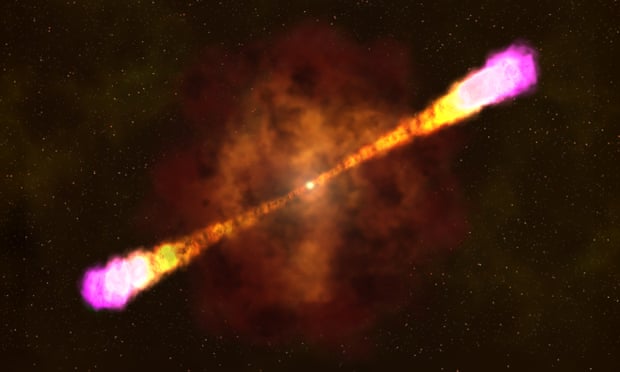Astronomers note record-breaking observation of highest energy ever measured from gamma ray bursts
Source: The Guardian
When gigantic stars run out of fuel they collapse under their own gravity and, in a last hurrah, send out a blast of light and matter in the most violent known explosions in the universe.
Now astronomers have discovered that these cataclysmic events, known as gamma ray bursts, release roughly twice as much energy as previously thought.
The rethink comes after an international team registered a record-breaking observation of the highest-energy radiation ever measured from gamma ray bursts.
“These are the craziest energies emitted – the most intense electromagnetic events known in the universe,” said Razmik Mirzoyan, an astrophysicist at the Max-Planck-Institute for Physics in Munich and spokesman for the Major Atmospheric Gamma Imaging Cherenkov (Magic) telescopes on La Palma. “Now it turns out that these gamma ray bursts are even more powerful than that.”
The discovery was made possible by a exquisitely choreographed alert system that allowed more than 20 ground-based telescopes to simultaneously record the same event.
Gamma ray bursts happen in the sky roughly once a day and a typical burst releases as much energy in a few seconds as the sun will in its entire 10bn-year lifetime.
They are thought to be the result of gigantic stars, 30-50 times the mass of the sun, collapsing under their own gravity when they run out of fuel. At this point they transform into a black hole or a small, dense neutron star and, in the process, blast out jets of radiation and matter at close to the speed of light.
The emission from the initial jet lasts only a few seconds, but an afterglow, which happens as the jet slows down in the surrounding interstellar medium, can be observed for hours after the event. On 14 January, the initial flash of a gamma ray burst was detected by a Nasa space telescope, which within seconds sent an alert to more powerful ground-based instruments.
The pair of Magic telescopes in La Palma were among those that had been programmed to automatically abandon any observations in the case of such an alert and point at the right bit of sky. Ground crew were taken by surprise when the 64-tonne telescopes swivelled by themselves and began observing an unknown event, just 58 seconds after it was logged by the Nasa instrument, allowing it to make the unprecedented detection.
Scientists calculate the amount of energy released in gamma ray bursts by measuring how many photons are detected in telescopes and how much energy each has. But the calculation is hampered by the fact that the highest-energy gamma rays, counterintuitively, are the least likely to make it all the way to Earth because they are more likely to interact with background light on the way.
“The burst was 4.5bn light years away. While the gamma ray is travelling this distance it has a certain chance to encounter low-energy photons, the so-called extragalactic background light, which is old light emitted by all the stars and all the galaxies during the entire lifetime of the universe and filling it like a gas,” said Mirzoyan. The highest-energy photons are more likely to be lost to these encounters.
The latest observations are the first to detect extremely high energy radiation released by gamma ray bursts, showing that previously unknown physical processes are taking place in the aftermath of the explosion and roughly doubling the total amount of energy thought to be released.
“If these high-energy emissions existed at all was an open question,” said Mirzoyan. “People were trying to chase this problem for 20 to 30 years without any success.”
The findings have since been confirmed by a separate team, who trawled through archive data and found further evidence for extremely high energy gamma rays in observations of another gamma ray burst from 2018. The findings are published in the journal Nature.
Source: The Guardian

































Leave a Comment
You must be logged in to post a comment.